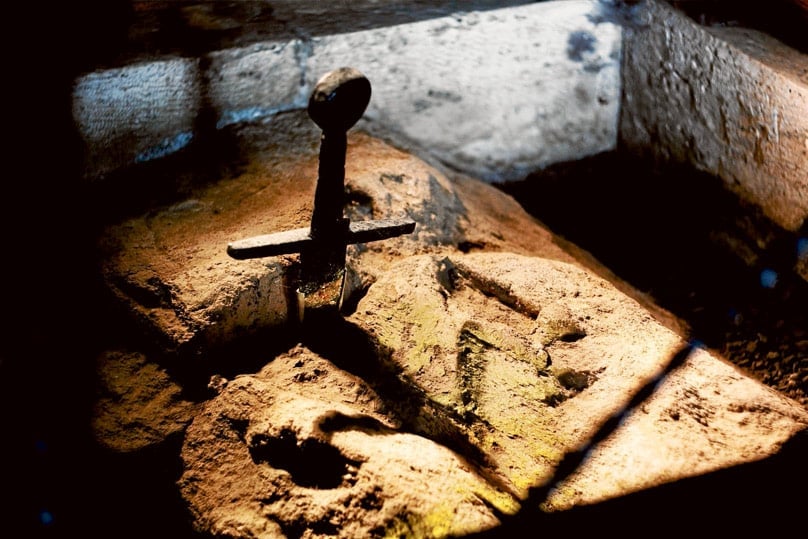
The recent release of the Guy Ritchie-directed film King Arthur – Legend of The Sword has led to another global revival of Arthurian literature which will be highlighted in Sydney this August with the new Artes Christi production of Lerner and Loewe’s classic musical Camelot.
The legends of King Arthur and Camelot have been retold and developed by countless writers dating back to at least the sixth century, but recent archaeological discoveries (as well as literary research) suggest that the Sword-in-the-Stone legend was directly inspired by a 12th Century Italian Saint Galgano Guidotti. The story goes that towards the end of his life, Galgano, who had previously been a violent and immoral soldier, had a vision in which the Archangel Michael invited him to change his life.
Galgano decided he would become a hermit and a second vision then told him he had to leave behind all licentiousness, to which the saint replied, “It would be easier to cut a stone with this sword than to do that.”
To Galgano’s surprise, when he went to stick his sword in the stone to prove his point, the sword sank like butter into the rock where it remains to this day.
Galgano died in 1181 and was canonised in 1185, being one of the first people to ever be canonised by a formal Church process (which has also ensured there is a significant amount of documented evidence on his life.)
In 1189 a chapel was built around the sword in Chiusdino about 30 kilometres outside Siena.
For centuries the sword was assumed to be a fake. But research in 2001 dated its metal as well as the design of the sword to the 12th century, matching it up with Saint Galgano Giudotti’s timeline and the legend of his sword.
The history of St Galgano was recently examined by Italian academic Mario Moiraghi, who made a comprehensive study comparing the history of St Galgano with the legends of Arthur.
In his book L’enigma di san Galgano, Moiraghi argues that the Arthurian legend of the sword in the stone was inspired by St Galgano’s sword in Tuscany.
Moiraghi points out that it’s only shortly after, in the decades following St Galgano’s canonisation in 1185 that the first references appear to Arthur’s Sword in the Stone in poems by the Burgundian poet Robert de Boron.
St Galgano’s story had obviously spread in this time from Italy across Europe and the legend of Saint Galgano thus formed the inspiration for the original stories of King Arthur and the Sword in the Stone.
Moiraghi also brought in the team of scientists from the University of Pavia who studied St Galgano’s sword, with the scientists verifying that the object dates from the 12th century.
“Dating metal is a very difficult task, but we can say that the composition of the metal and the style are compatible with the era of the legend,” said Luigi Garlaschelli, of the University of Pavia.
“We have succeeded in refuting those who maintain that it is a recent fake.” Says Moiraghi: “The sword which, having been plunged into the stone becomes a cross; this is a true symbol of the Christian life — the transformation of violence into love.”
And this symbolism of the Sword as a Crucifix is picked up and highlighted in the final scene of Lerner and Loewe’s musical Camelot where the stage direction explicitly asks the actor playing Arthur to hold up the sword Excalibur “like a Crucifix.”
“Camelot is a beautiful and inspiring tale of medieval faith and the glory of Christendom which transformed the foundations of society,” says the director Jeremy Ambrose, who is directing his third Artes Christi production after The Wiz (2013) and The Importance of Being Earnest (2015).
“Camelot is a story that explores many important Christian themes, amongst them the age-old battle of virtue vs vice, playfully tempting us with the attractiveness of sin, and yet clearly revealing the horror and destruction of its effects, for both the person and society.
“And even religious life gets a plug, and in the last scene of the show – you don’t see that very often!”
With over 3,000 tickets available and over 75 people in the cast and orchestra, this new production of Camelot is one of the largest scale versions of the musical to be staged in Sydney since Richard Harris starred as King Arthur in the 1984 touring production alongside a 21 year old Marina Prior as Guenevere.
This new Artes Christi production stars Berlin HdK-trained tenor Paul McLeod as King Arthur, Royal Central UK-trained Emily Potts as Guenevere with NZ and Australian Opera singer Benjamin Caukwell as Lancelot.
Acclaimed stage, TV and film actor Donald Macdonald will also be making a special guest appearance as Merlyn.
Camelot tickets are strictly limited with Concession, Group and Family prices starting from $35 each. For full details or to book visit www.Camelot2017.com or call (02) 9351 7940.
Camelot: 18-20 August, Seymour Centre (Cnr City Rd Chippendale, near Sydney University).
